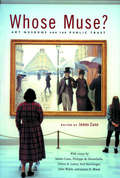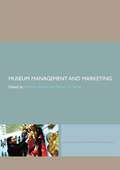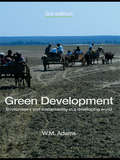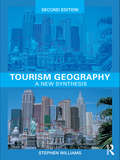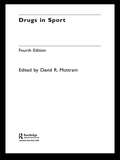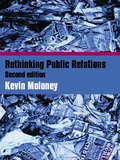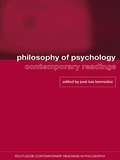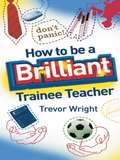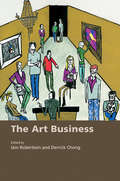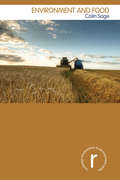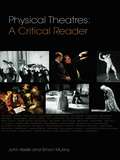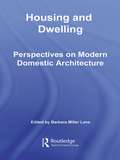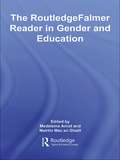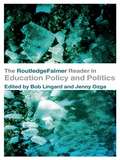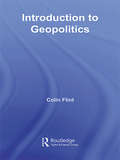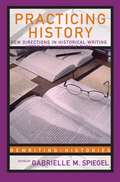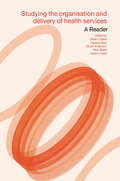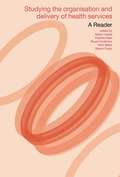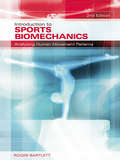- Table View
- List View
Whose Muse?: Art Museums and the Public Trust (PDF)
by James Cuno Philippe De Montebello Neil MacGregor John Walsh Glenn D. Lowry James N. WoodDuring the economic boom of the 1990s, art museums expanded dramatically in size, scope, and ambition. They came to be seen as new civic centers: on the one hand as places of entertainment, leisure, and commerce, on the other as socially therapeutic institutions. But museums were also criticized for everything from elitism to looting or illegally exporting works from other countries, to exhibiting works offensive to the public taste. Whose Muse? brings together five directors of leading American and British art museums who together offer a forward-looking alternative to such prevailing views. While their approaches differ, certain themes recur: As museums have become increasingly complex and costly to manage, and as government support has waned, the temptation is great to follow policies driven not by a mission but by the market. However, the directors concur that public trust can be upheld only if museums continue to see their core mission as building collections that reflect a nation's artistic legacy and providing informed and unfettered access to them. The book, based on a lecture series of the same title held in 2000-2001 by the Harvard Program for Art Museum Directors, also includes an introduction by Cuno and a fascinating--and surprisingly frank--roundtable discussion among the participating directors. A rare collection of sustained reflections by prominent museum directors on the current state of affairs in their profession, this book is without equal. It will be read widely not only by museum professionals, trustees, critics, and scholars, but also by the art-loving public itself.
Museum Management and Marketing (Leicester Readers in Museum Studies)
by Richard Sandell Robert R. JanesDrawing together a selection of high quality, intellectually robust and stimulating articles on both theoretical and practice-based developments in the field, this Reader investigates the closely linked areas of management and marketing in the museum. The articles, from established and world-renowned contributors, practitioners and writers at the leading edge of their fields, deal with the museum context of management and how marketing and management practices must take account of the specifics of the museum and the not-for-profit ethos. Key writings from broader literature are included, and the collection of key writings on the investigation and study of management and marketing in the museum are of great benefit not only to those studying the subject, but also to professionals working and developing within the field.
Green Development: Environment and Sustainability in a Developing World
by Bill AdamsThe concept of sustainability lies at the core of the challenge of environment and development and the way governments, business and environmental groups respond to it. Green Development provides a clear and coherent analysis of sustainable development in both theory and practice. This third edition retains the clear and powerful argument of previous editions, but has been updated to reflect advances in ideas and changes in international policy. Greater attention has been given to political ecology, environmental risk and the environmental impacts of development. This fully revised third edition discusses: the origins of thinking about sustainability and sustainable development and its evolution to the present day the ideas that dominate mainstream sustainable development (ecological modernization, market environmentalism and environmental economics) the nature and diversity of alternative ideas about sustainability that challenge ‘business as usual’ thinking (for example ecosocialism, ecofeminism, deep ecology and political ecology) the dilemmas of sustainability in the context of dryland degradation, deforestation, biodiversity conservation, dam construction and urban and industrial development the nature of policy choices about the environment and development strategies and between reformist and radical responses to the contemporary global dilemmas. Green Development offers clear insights into the challenges of environmental sustainability and social and economic development. It is unique in offering a synthesis of theoretical ideas on sustainability and in its coverage of the extensive literature on the environment and development around the world. This book has proved its value to generations of students as an authoritative, thought-provoking and readable guide to the field of sustainable development.
Tourism Geography: A New Synthesis
by Stephen WilliamsTourism is an intensely geographic phenomenon. It stimulates large-scale, global movement of people and forges distinctive relationships between people and the places they visit. It shapes processes of physical development and resource exploitation, whilst the presence of visitors exerts a range of economic, social, cultural and environmental impacts that often have important implications for local geographies. This second edition of Tourism Geography develops a critical understanding of how different geographies of tourism are created and maintained. Drawing on both historical and contemporary perspectives, the discussion – which is in three main parts – connects tourism to key geographical concepts relating to globalization, mobility, new geographies of production and consumption, and post-industrial change. Part one examines how spatial patterns of tourism are formed and evolve through time. Part two offers an extended discussion of how tourism relates to places that are toured, examining physical and economic development, socio-cultural and environmental relations and the role of tourism planning. Part three develops a range of new material for this second edition that considers important contemporary influences upon tourism geographies, including place promotion, new forms of urban tourism, heritage, identity and embodied forms of tourism. Featuring international case studies and supported by up-to-date statistics, the text offers a concise yet comprehensive review of tourism geography and how geographers can interpret this important contemporary process. Written primarily as a student text, each chapter includes guidance for further study and summary bibliographies that form the basis for independent work.
Drugs in Sport
by David R. MottramWith the recent major updates in worldwide anti-doping laws and changes to the prohibited and therapeutic exemption lists, this fourth edition of the bestselling Drugs in Sport presents authoritative, hard science information about the actions of drugs, hormones, medication and nutritional supplements in sport. Written by a well respected pharmacologist from one of the UK’s leading sports science universities, this much-needed new edition of a market leader continues to focus on one of the most high profile themes in sport science, providing high quality detailed information. Some of the key issues covered include: * the latest doping control regulations of the WADA* the use of therapeutic drugs banned in sport* an assessment of the prevalence of drug taking in sport.
Rethinking Public Relations: PR Propaganda and Democracy
by Kevin MoloneyAll PR, whether for charities or arms manufacturers, is weak propaganda. Though it has its undeniable benefits (it grabs attention and helps circulate more information), it also has costs (such as selective messaging). This extensively revised edition of a classic text fully investigates PR, updating and expanding earlier arguments and building upon the successful first edition with new thoughts, data and evidence. Thought-provoking and stimulating, Rethinking Public Relations 2nd Edition challenges conventional PR wisdom. It develops the accepted thinking on the most important question facing PR - its relationship with democracy - and finds a balance of advantages and disadvantages which leave a residue of concern. It tackles topical issues such as: PR as a form of propaganda which flourishes in a democracy the connections between PR and journalism the media, promotions culture and persuasion. Designed to appeal to final year undergraduates, postgraduates and researchers studying public relations, media and communications studies, this book explores the most important relationship PR has – the connection with democracy – and asks what benefits or costs it brings to politics, markets and the media.
Philosophy of Psychology: Contemporary Readings (Routledge Contemporary Readings in Philosophy)
by Jose Luis BermudezPhilosophy of Psychology: Contemporary Readings is a comprehensive anthology that includes classic and contemporary readings from leading philosophers. Addressing in depth the major topics within philosophy of psychology, the editor has carefully selected articles under the following headings: pictures of the mind commonsense psychology representation and cognitive architecture. Articles by the following philosophers are included: Blackburn, Churchland, Clark, Cummins, Dennett, Davidson, Fodor, Kitcher, Lewis, Lycan, McDowell, McLeod, Rey, Segal, Stich. Each section includes a helpful introduction by the editor which aims to guide the student gently into the topic. The book is highly accessible and provides a broad-ranging exploration of the subject, including discussion of the leading philosophers in the field. Ideal for any student of philosophy of psychology or philosophy of mind.
Philosophy of Psychology: Contemporary Readings (Routledge Contemporary Readings in Philosophy)
by Jose Luis BermudezPhilosophy of Psychology: Contemporary Readings is a comprehensive anthology that includes classic and contemporary readings from leading philosophers. Addressing in depth the major topics within philosophy of psychology, the editor has carefully selected articles under the following headings: pictures of the mind commonsense psychology representation and cognitive architecture. Articles by the following philosophers are included: Blackburn, Churchland, Clark, Cummins, Dennett, Davidson, Fodor, Kitcher, Lewis, Lycan, McDowell, McLeod, Rey, Segal, Stich. Each section includes a helpful introduction by the editor which aims to guide the student gently into the topic. The book is highly accessible and provides a broad-ranging exploration of the subject, including discussion of the leading philosophers in the field. Ideal for any student of philosophy of psychology or philosophy of mind.
How to be a Brilliant Trainee Teacher: Developing Outstanding Trainees
by Trevor WrightThis cheerful and accessible book is packed with direct and straightforward advice drawn from the author’s extensive and successful personal experience as teacher-trainer, teacher and examiner. It sets out clear and practical guidelines to support your training and enhance your teaching, moving you directly towards a real understanding of how and why pupils learn and of how you can enhance your own progress. It also offers reassurance and support with the difficulties which you might encounter through your training as a teacher. Why won’t Year 8 actually do anything? Why do we have to read all this theory? I know my pace and timing need improvement, but what do I actually do about it? Why haven’t I moved forward at all in the last four weeks? It does this by: outlining strategies for organization exploring issues of personal development demystifying areas often seen as difficult or complex providing achievable and practical solutions directly addressing anxieties. Although a practical book, at its heart lie essential principles about good teaching and learning. It is anecdotal and readable, and may be dipped into for innovative lesson ideas or read from cover-to-cover as a short, enjoyable course which discovers exciting teaching principles in successful, practical experience. The book is ideal for secondary trainee teachers, but the underlying principles about what makes a brilliant trainee teacher are applicable to primary trainees too.
How to be a Brilliant Trainee Teacher
by Trevor WrightThis cheerful and accessible book is packed with direct and straightforward advice drawn from the author’s extensive and successful personal experience as teacher-trainer, teacher and examiner. It sets out clear and practical guidelines to support your training and enhance your teaching, moving you directly towards a real understanding of how and why pupils learn and of how you can enhance your own progress. It also offers reassurance and support with the difficulties which you might encounter through your training as a teacher. Why won’t Year 8 actually do anything? Why do we have to read all this theory? I know my pace and timing need improvement, but what do I actually do about it? Why haven’t I moved forward at all in the last four weeks? It does this by: outlining strategies for organization exploring issues of personal development demystifying areas often seen as difficult or complex providing achievable and practical solutions directly addressing anxieties. Although a practical book, at its heart lie essential principles about good teaching and learning. It is anecdotal and readable, and may be dipped into for innovative lesson ideas or read from cover-to-cover as a short, enjoyable course which discovers exciting teaching principles in successful, practical experience. The book is ideal for secondary trainee teachers, but the underlying principles about what makes a brilliant trainee teacher are applicable to primary trainees too.
The Art Business
by Iain RobertsonBy the time you read this book, the art world may have witnessed the sale of its first $500 million painting. Whilst for some people money is anathema to art this is clearly a wealthy international industry, and a market with its own conventions and pressures. Drawing on the vast experience of Sotheby’s Institute of Art, The Art Business exposes the realities of the commercial trade in fine art and antiques. Attention is devoted to the role of auction houses, commercial galleries and art museums as key institutions, with the text divided into four thematic sections covering: technical and structural elements of the art market cultural policy and management in art business regulatory legal and ethical issues in the art world the views, through interviews, of leading art market experts. This book provides a thorough examination of contemporary issues in the art business, and the mechanisms and influences which underpin its evolution. It is essential reading for students of art history or international business, or anyone with an interest in pursuing a career in this area.
Environment and Food (Routledge Introductions to Environment: Environment and Society Texts)
by Colin SageThis timely book provides a thorough introduction to the inter-relationship of food and the environment. Its primary purpose is to bring to our attention the multiplicity of linkages and interconnections between what we eat and how this impacts on the earth’s resources. Having a better idea of the consequences of our food choices might encourage us to develop more sustainable practices of production and consumption in the decades ahead. Although human societies have, over time, brought under control a large proportion of the earth’s resources for the purpose of food production, we remain subject to the effective functioning of global ecosystem services. The author highlights the vital importance of these services and explains why we should be concerned about the depletion of freshwater resources, soil fertility decline and loss of biological diversity. The book also tackles some of the enormous challenges of our era: climate change – to which the agri-food system is both a major contributor and a vulnerable sector – and the prospect of significantly higher energy prices, arising from the peaking of oil and gas supplies which will reveal how dependent the food system has become upon cheap fossil fuels. Such challenges are likely to have significant implications for the long-term functioning of global supply chains and raise profound questions regarding the nutritional security of the world’s population. Taken together the book argues that a re-examination of the assumptions and practices underpinning the contemporary food system is urgently required. Environment and Food is a highly original, inter-disciplinary and accessible text that will be of interest to students and the wider public genuinely interested in and concerned by the state of the world’s food provisioning system. It is richly illustrated with figures and makes extensive use of boxes to highlight relevant examples.
Physical Theatres: A Critical Reader
by John Keefe Simon MurrayPhysical Theatres: A Critical Reader is an invaluable resource for students of physically orientated theatre and performance. This book aims to trace the roots and development of physicality in theatre by combining practical experience of the field with a strong historical and theoretical underpinning. In exploring the histories, cross-overs and intersections of physical theatres, this critical Reader provides: six new, specially commissioned essays, covering each of the book’s main themes, from technical traditions to contemporary practises discussion of issues such as the foregrounding of the body, training and performance processes, and the origins of theatre in both play and human cognition a focus on the relationship and tensions between the verbal and the physical in theatre contributions from Augusto Boal, Stephen Berkoff, Étienne Decroux, Bertolt Brecht, David George, J-J. Rousseau, Ana Sanchez Colberg, Michael Chekhov, Jeff Nuttall, Jacques Lecoq, Yoshi Oida, Mike Pearson, and Aristotle.
Physical Theatres: A Critical Reader
by John Keefe Simon MurrayPhysical Theatres: A Critical Reader is an invaluable resource for students of physically orientated theatre and performance. This book aims to trace the roots and development of physicality in theatre by combining practical experience of the field with a strong historical and theoretical underpinning. In exploring the histories, cross-overs and intersections of physical theatres, this critical Reader provides: six new, specially commissioned essays, covering each of the book’s main themes, from technical traditions to contemporary practises discussion of issues such as the foregrounding of the body, training and performance processes, and the origins of theatre in both play and human cognition a focus on the relationship and tensions between the verbal and the physical in theatre contributions from Augusto Boal, Stephen Berkoff, Étienne Decroux, Bertolt Brecht, David George, J-J. Rousseau, Ana Sanchez Colberg, Michael Chekhov, Jeff Nuttall, Jacques Lecoq, Yoshi Oida, Mike Pearson, and Aristotle.
Housing and Dwelling: Perspectives on Modern Domestic Architecture
by Barbara Miller LaneHousing and Dwelling collects the best in recent scholarly and philosophical writings that bear upon the history of domestic architecture in the nineteenth and twentieth centuries. Lane combines exemplary readings that focus on and examine the issues involved in the study of domestic architecture, taken from an innovative and informed combination of philosophy, history, social science, art, literature and architectural writings. Uniquely, the readings underline the point of view of the user of a dwelling and assess the impact of varying uses on the evolution of domestic architecture. This book is a valuable asset for students, scholars, and designers alike, exploring the extraordinary variety of methods, interpretations and source materials now available in this important field. For students, it opens windows on the many aspects of domestic architecture. For scholars, it introduces new, interdisciplinary points of view and suggests directions for further research. It acquaints practising architects in the field of housing design with history and methods and offers directions for future design possibilities.
Housing and Dwelling: Perspectives on Modern Domestic Architecture
by Barbara Miller LaneHousing and Dwelling collects the best in recent scholarly and philosophical writings that bear upon the history of domestic architecture in the nineteenth and twentieth centuries. Lane combines exemplary readings that focus on and examine the issues involved in the study of domestic architecture, taken from an innovative and informed combination of philosophy, history, social science, art, literature and architectural writings. Uniquely, the readings underline the point of view of the user of a dwelling and assess the impact of varying uses on the evolution of domestic architecture. This book is a valuable asset for students, scholars, and designers alike, exploring the extraordinary variety of methods, interpretations and source materials now available in this important field. For students, it opens windows on the many aspects of domestic architecture. For scholars, it introduces new, interdisciplinary points of view and suggests directions for further research. It acquaints practising architects in the field of housing design with history and methods and offers directions for future design possibilities.
The RoutledgeFalmer Reader in Gender & Education (RoutledgeFalmer Readers in Education)
by Madeleine Arnot Mairtin Mac GhaillThis new Reader brings together classic pieces of gender theory, as well as examples of the sophistication of contemporary gender theory and research methodologies in the field of education. Leading international gender researchers address current debates about gender, power, identity and culture and concerns about boys’ and girls’ schooling, gender achievement patterns, the boys’ education debate, and gender relationships in the curriculum, the classroom and youth cultures. The Reader is divided into six sections which reflect contemporary concerns about Gender and Education: Gender and Educational Theory Difference and Power Identity Work Knowledge and Pedagogy Reflexivity and Risk Gender and Citizenship. A specially written Introduction from the editors, both experts in feminist and masculinity research, provides a much-needed context to the current educational climate. Undergraduates, postgraduates and academics interested in education, gender studies and women’s studies will find this a stimulating and important resource. The analysis of the gender dimensions of the curriculum, teaching and alternative pedagogies also provide important insights for practitioners wishing to promote gender equality.
The RoutledgeFalmer Reader in Education Policy and Politics (RoutledgeFalmer Readers in Education)
by Bob Lingard Jenny OzgaThis Reader brings together selected papers from leading scholars to address the most significant recent development in educational policy and politics: the impact of globalisation. The papers discuss, document and analyse evidence of globalisation’s effects on the new direction of education policies and practices, and in the production of globalised agendas for the redesign of state provision and the governance of education. The Reader is organised in two parts. The first part provides a selection of articles that interrogate globalisation and its effects from a variety of analytical perspectives, and explore what kind of politics are possible in the framing context of globalisation. The second part documents and discusses different types of engagement with politics and policy in a variety of settings and sectors, including numerous European and Pacific Rim policy contexts. This important collection underlines the need to approach globalisation, education policy and politics from numerous perspectives, and offers analytical, empirical and theoretical resources for the reframing of contemporary education politics. Students of educational policy and politics will find this Reader an invaluable resource for understanding, theorising and researching in these academic fields.
Introduction to Geopolitics
by Colin FlintThis clear and concise introductory textbook guides students through their first engagement with geopolitics. It offers a clear framework for understanding contemporary conflicts by showing how geography provides opportunities and limits upon the actions of countries, national groups, and terrorist organizations, and the overarching theme of geopolitical structures and agents requires no previous knowledge of theory or current affairs. Throughout the book, case studies, including the rise of al Qaeda, the Korean conflict, Israel-Palestine, Chechnya and Kashmir, emphasize the multi-faceted nature of conflict. These, along with guided exercises, help explain contemporary global power struggles, the global military actions of the United States, the persistence of nationalist conflicts, the changing role of borders, and the new geopolitics of terrorism. Throughout, the readers are introduced to different theoretical perspectives, including feminist contributions, as both the practice and representation of geopolitics are discussed. Introduction to Geopolitics is extensively illustrated with diagrams, maps, and photographs. Reading this book will provide a deeper and critical understanding of current affairs and facilitate access to higher level course work and essays on geopolitics. Both students and general readers alike will find this book an essential stepping-stone to understanding contemporary conflicts.
Introduction to Geopolitics
by Colin FlintThis clear and concise introductory textbook guides students through their first engagement with geopolitics. It offers a clear framework for understanding contemporary conflicts by showing how geography provides opportunities and limits upon the actions of countries, national groups, and terrorist organizations, and the overarching theme of geopolitical structures and agents requires no previous knowledge of theory or current affairs. Throughout the book, case studies, including the rise of al Qaeda, the Korean conflict, Israel-Palestine, Chechnya and Kashmir, emphasize the multi-faceted nature of conflict. These, along with guided exercises, help explain contemporary global power struggles, the global military actions of the United States, the persistence of nationalist conflicts, the changing role of borders, and the new geopolitics of terrorism. Throughout, the readers are introduced to different theoretical perspectives, including feminist contributions, as both the practice and representation of geopolitics are discussed. Introduction to Geopolitics is extensively illustrated with diagrams, maps, and photographs. Reading this book will provide a deeper and critical understanding of current affairs and facilitate access to higher level course work and essays on geopolitics. Both students and general readers alike will find this book an essential stepping-stone to understanding contemporary conflicts.
Practicing History: New Directions in Historical Writing after the Linguistic Turn (Rewriting Histories)
by Gabrielle M. SpiegelThis essential collection of key articles offers a re-evaluation of the practice of history in light of current debates. Critical thinkers and practicing historians present their writings, along with clear and thorough editorial material, to examine the complex ideas at the forefront of historical practice. This volume gives a synoptic overview of the last twenty-five years’ theoretical analysis of historical writing, with a critical examination of the central concepts and positions that have been in debate. The collection delineates the emergence of "practice theory" as a possible paradigm for future historical interpretation concerned with questions of agency, experience and the subject. These complex ideas are introduced to students in this accessible reader, and for teachers and historians too, this survey is an indispensable and timely read.
Practicing History: New Directions in Historical Writing after the Linguistic Turn (Rewriting Histories)
by Gabrielle M. SpiegelThis essential collection of key articles offers a re-evaluation of the practice of history in light of current debates. Critical thinkers and practicing historians present their writings, along with clear and thorough editorial material, to examine the complex ideas at the forefront of historical practice. This volume gives a synoptic overview of the last twenty-five years’ theoretical analysis of historical writing, with a critical examination of the central concepts and positions that have been in debate. The collection delineates the emergence of "practice theory" as a possible paradigm for future historical interpretation concerned with questions of agency, experience and the subject. These complex ideas are introduced to students in this accessible reader, and for teachers and historians too, this survey is an indispensable and timely read.
Studying the Organisation and Delivery of Health Services: A Reader (Social Aspects Of Aids Ser.)
by Pauline Allen Nick Black Aileen Clarke Naomi Fulop Stuart AndersonResearch into the delivery and organisation of health care is a vital component in the improvement of health services. A wide range of disciplines and methods needs to be deployed to address research questions in this field. This unique reader brings together thirty examples of high-quality SDO research using a range of disciplines, including organisational studies, epidemiology, sociology, history, health economics, anthropology and policy studies, illustrating the use of qualitative and quantitative approaches and primary and secondary research. Expert editorial commentary on each section highlights different themes and methodological issues. The reader covers six main areas of research: Organising services around the user User involvement in organising services Workforce issues Evaluating models of service delivery Quality management and the management of change Studying health care organisations. This book is a companion volume to Studying the Organisation and Delivery of Health Services: Research Methods also published by Routledge (2001). It makes top-quality, empirical and secondary research readily accessible to health service managers and health care professionals who are interested in research, to health service researchers and to undergraduate and postgraduate students following courses in health and health management studies.
Studying the Organisation and Delivery of Health Services: A Reader
by Pauline Allen Nick Black Aileen Clarke Naomi Fulop Stuart AndersonResearch into the delivery and organisation of health care is a vital component in the improvement of health services. A wide range of disciplines and methods needs to be deployed to address research questions in this field. This unique reader brings together thirty examples of high-quality SDO research using a range of disciplines, including organisational studies, epidemiology, sociology, history, health economics, anthropology and policy studies, illustrating the use of qualitative and quantitative approaches and primary and secondary research. Expert editorial commentary on each section highlights different themes and methodological issues. The reader covers six main areas of research: Organising services around the user User involvement in organising services Workforce issues Evaluating models of service delivery Quality management and the management of change Studying health care organisations. This book is a companion volume to Studying the Organisation and Delivery of Health Services: Research Methods also published by Routledge (2001). It makes top-quality, empirical and secondary research readily accessible to health service managers and health care professionals who are interested in research, to health service researchers and to undergraduate and postgraduate students following courses in health and health management studies.
Introduction to Sports Biomechanics: Analysing Human Movement Patterns
by Roger BartlettIntroduction to Sports Biomechanics provides a genuinely accessible and comprehensive guide to all of the biomechanics topics covered in an undergraduate sports and exercise science degree. Now revised and in its second edition, Introduction to Sports Biomechanics is full of visual aids to support the text. Every chapter contains cross references to key terms and definitions from that chapter, learning objectives and summaries, study tasks to confirm and extend your understanding, and suggestions to further your reading. Clearly structured and with many student friendly features, the text covers: movement patterns – exploring the essence and purpose of movement analysis qualitative analysis of sports movements movement patterns and the geometry of motion quantitative measurement and analysis of movement force and torques – causes of movement the human body and the anatomy of movement. This edition is supported by a website containing animation and video clips, and offers sample data tables for comparison and analysis and multiple choice questions to confirm your understanding of the material in each chapter. Introduction to Sports Biomechanics is a must have for students of sport and exercise, human movement sciences, ergonomics, biomechanics, and sports performance and coaching. Visit the companion website at: www.routledge.com/textbooks/9780415339940.
